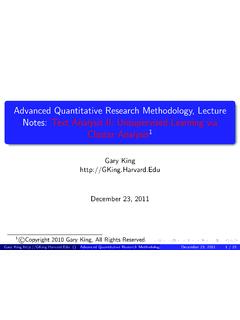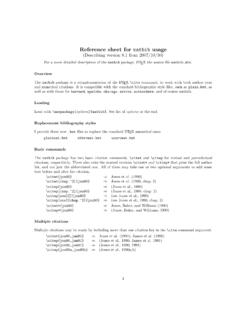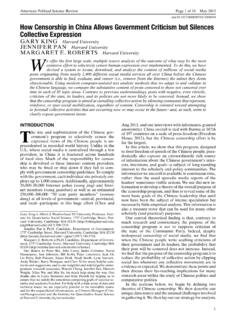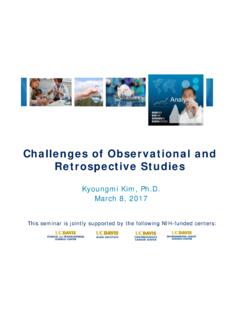Transcription of Why Propensity Scores Should Not Be Used for Matching
1 Why Propensity ScoresShould Not Be Used for Matching Gary King Richard Nielsen November 10, 2018 AbstractWe show that Propensity score Matching (PSM), an enormously popular method ofpreprocessing data for causal inference, often accomplishes the opposite of its in-tended goal thus increasing imbalance, inefficiency, model dependence, and weakness of PSM comes from its attempts to approximate a completely random-ized experiment, rather than, as with other Matching methods, a more efficient fullyblocked randomized experiment. PSM is thus uniquely blind to the often large por-tion of imbalance that can be eliminated by approximating full blocking with othermatching methods. Moreover, in data balanced enough to approximate completerandomization, either to begin with or after pruning some observations, PSM ap-proximates random Matching which, we show, increases imbalance even relative tothe original data.
2 Although these results suggest researchers replace PSM with one ofthe other available Matching methods, Propensity Scores have other productive uses. The current version of this paper, along with a Supplementary Appendix, can be found at thank Alberto Abadie, Alan Dafoe, Justin Grimmer, Jens Hainmueller, Chad Hazlett, Seth Hill, StefanoIacus, Kosuke Imai, Simon Jackman, John Londregan, Adam Meirowitz, Giuseppe Porro, Molly Roberts,Jamie Robins, Bradley Spahn, Brandon Stewart, Liz Stuart, Chris Winship, and Yiqing Xu for helpfulsuggestions, and Connor Jerzak, Chris Lucas, Jason Sclar for superb research assistance. We also appreciatethe insights from our collaborators on a previous related project, Carter Coberley, James E. Pope, and AaronWells. All data necessary to replicate the results in this article are available at R. Nielsen and King (2018). Institute for Quantitative Social Science, Harvard University, 1737 Cambridge Street, Cambridge MA02138; , (617) 500-7570.
3 Department of Political Science, Massachusetts Institute of Technology, 77 Massachusetts Avenue,Cambridge, MA 02139; rnielsen, (857) IntroductionMatching is an increasingly popular method for preprocessing data to improve causal in-ferences in observational data (Ho et al., 2007; Morgan and Winship, 2014). The goalof Matching is to reduce imbalance in the empirical distribution of the pre-treatment con-founders between the treated and control groups (Stuart, 2010, ). Lowering imbalancereduces, or reduces the bound on, the degree of model dependence in the statistical es-timation of causal effects (Ho et al., 2007; Iacus, King, and Porro, 2011; Imai, King,and Stuart, 2008), and, as a result, reduces inefficiency, and bias. The resulting processamounts to a search for a data set that might have resulted from a randomized experi-ment but is hidden in an observational data set. When Matching can reveal this hiddenexperiment, many of the problems of observational data analysis score Matching (PSM) (Paul R.)
4 Rosenbaum and Rubin, 1983) is the mostcommonly used Matching method, possibly even the most developed and popular strat-egy for causal analysis in observational studies (Pearl, 2010). It is used or referenced inover 127,000 scholarly show here that PSM, as it is most commonly used in practice (or with many of therefinements that have been proposed by statisticians and methodologists), increases im-balance, inefficiency, model dependence, research discretion, and statistical bias at somepoint in both real data and in data generated to meet the requirements of PSM theory. Infact, the more balanced the data, or the more balanced it becomes by pruning some ob-servations through Matching , the more likely PSM will degrade inferences a problemwe refer to as thePSM paradox. If one s data are so imbalanced that making valid causalinferences from it without heavy modeling assumptions is impossible, then the paradoxwe identify is avoidable and PSM will reduce imbalance but then the data are not veryuseful for causal inference by any trace the PSM paradox to the particular way Propensity Scores interact with match-ing.
5 Thus, our results do not necessarily implicate the many other productive uses ofpropensity Scores , such as regression adjustment (Vansteelandt and Daniel, 2014), inverse1 Count according to Google Scholar, accessed 11/8/2018, searching for: Propensity score AND( Matching OR matched OR match).1weighting (Robins, Hernan, and Brumback, 2000), stratification (Paul R. Rosenbaum andRubin, 1984), and some uses of the Propensity score within other methods ( Diamondand Sekhon, 2012; Imai and Ratkovic, 2014). Moreover, the mathematical theorems inthe literature used to justify Propensity Scores in general, such as in Paul R. Rosenbaumand Rubin (1983), are of course correct and useful elsewhere, but we show they are notrelevant to the practice of define the neglected but essential problem of model dependence in causal infer-ence in Section 2. Suboptimal Matching leads to unnecessary imbalance, which generatesmodel dependence, researcher discretion, and statistical bias.
6 Section 3 then proves howsuccessfully applied Matching methods can reduce model dependence. In Section 4, weshow that PSM is blind to an important source of information in observational studiesbecause it approximates a completely randomized rather than a more informative andpowerful, fully blocked experiment. It also explains the inadequacies of the statisticaltheory used to justify PSM. We then show, in Section 5, that PSM s weaknesses are notmerely a matter of some avoidable inefficiency. Instead, when data are well balanced ei-ther to begin with or after pruning some observations by Matching , the fact that PSM isapproximating the coin flips of a completely randomized experiment means that it willprune observations approximately randomly, which we show increases imbalance, modeldependence, and bias. As a result, other Matching methods will usually achieve lowerlevels of imbalance than PSM, even given the same number of observations pruned, anddo not generate a similar paradox until much later in the pruning process, when a fullyblocked experiment is approximated and pruning is more obviously not , since other commonly used Matching methods reduce imbalance, modeldependence, and bias more effectively than PSM, and do not typically suffer from thesame paradox, Matching in general Should remain a highly recommended method ofcausal inference.
7 Section 6 offers advice to those who wish to use PSM despite the prob-lems and to those using other methods. Our Supplementary Appendix reports extensivesupporting information and The Problem of Model Dependence in Causal InferenceOur results apply more generally, but for expository reasons we focus on the simplestprobative case. Methodologists often recommend more sophisticated approaches that en-compass this simple case but, as our Supplementary Appendix demonstrates, the coreintuition from the setup we give here affects these approaches in the same way, and hasthe advantage of being easier to understand. Thus, for uniti(i= 1,..,n), denote thetreatment variable asTi {0,1}, where 0 refers to the control group and 1 the treatedgroup . LetXidenote a vector ofkpre-treatment covariates andYia scalar outcomevariable. In observational data, the process by which values ofTare assigned is notnecessarily random, controlled by the researcher, or Causal Quantities of InterestDenoteYi(1)andYi(0)as the potential outcomes, the valuesYiwould take on if treat-ment or control were applied, respectively.
8 Only one of the potential outcomes is observedfor each uniti,Yi=TiYi(1) + (1 Ti)Yi(0)(Holland, 1986; Rubin, 1974). The treatmenteffect for unitiis then the difference TEi=Yi(1) Yi(0).To clarify this notation, we require two assumptions (Imbens, 2004). For expositorysimplicity, but without loss of generality, we focus on treated units with, by definition,unobserved values ofY(0). First, in order forYi(0)and TEi Yi Yi(0)to logicallyexist, we make theoverlap assumption:0<Pr(Ti= 0|X)<1for alli(see alsoHeckman, Ichimura, and P. Todd, 1998, ) or, for example, that it is conceivablethat any unit actually assigned treatment could have been assigned control. Second, forTEito be a fixed quantity to be estimated, even assuming it exists, we also assume thestable unit treatment value assumption (SUTVA)(Rubin, 1980; VanderWeele and Hernan,2012), which requires that the potential outcomes are fixed and so, for example, the valueofYi(0)does not change ifTi, orTj j6=i, changes from 0 to quantities of interest are then averages of TEiover different subsets of unitsin the sample, or the population from which we can imagine the sample was drawn.
9 Forsimplicity, we focus on the sample average treatment effect (SATE), = meani(TEi),or the sample average treatment effect on the treated (SATT), = meani {i|Ti=1}(TEi)3(where for setSwith cardinality#S, the mean overiof functiong(i)ismeani S[g(i)] =1#S #Si=1g(i)). IdentificationFor identification, we make theunconfoundedness assumption(or selection on observ-ables, conditional independence, or ignorable treatment assignment ), which is thatthe values of the potential outcomes are determined in a manner conditionally independentof the treatment assignment:[Y(0),Y(1)] T|X(Barnow, Cain, and Goldberger, 1980;Lechner, 2001; Paul R. Rosenbaum and Rubin, 1983). A reasonable way to try to satisfythis assumption is to include inXany variable known to affect eitherYorT, since if anysubset of these variables satisfies unconfoundedness, this set will too (VanderWeele andShpitser, 2011).Then, along with overlap and SUTVA from Section , we can identify the quantitiesof interest.
10 For example, using unconfoundedness, we can identifyE[Y(0)|X=x]as:E[Y(0)|X=x] =E[Y(0)|T= 0,X=x] =E[Y|T= 0,X=x].(1)Then, extending the logic to the average identifies (Imbens, 2004, ). Estimation AmbiguityWhen feasible, we may estimate unobserved potential outcomes via exact Matching . Forexample, we can estimate SATT with theexact Matching estimator, = meani {i|Ti=1}[Yi Yi(0)], where Yi(0) = meanj {j|Xj=Xi,Ti=1,Tj=0}Yj. Given the identification result inEquation 1, this estimator is unbiased:E( ) = .Although exact Matching is possible in hypothetical asymptotic samples, it is rarelyfeasible in real data the common situation where exact matches are unavailable2If some treated units have insufficiently good matches and are thereby pruned as part of the matchingprocedure, then the feasible SATT (or FSATT) or SATE (FSATE) may be used instead. Using FSATT orFSATE is widely recommended by statisticians (and widely used in applied research) and is appropriate solong as one is careful to characterize the resulting quantity of interest (see Crump et al.)







